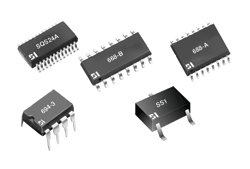For stability in medical and aerospace electronics, thin-film is in
BY MIKE TORRES
BI Technologies
Fullerton, CA
http://www.bitechnologies.com
From instrument amplifiers to precision analog circuits to geophones, resistor networks are used in a variety of applications. Each has its own unique requirements, but none more stringent than the high-reliability applications found in medical and aerospace industries.
In ultrasound equipment, for example, circuits require tight resistor tolerances and excellent tracking. Plane flight controllers or calculators demand precision resistors, while also requiring that components meet tight size constraints. Long-life stability is important for resistor networks in these applications.

Precision thin-film networks are available on ceramic and silicon-based substrates.
Resistor networks are best realized with thin-film resistor technology, which offers the flexibility to implement either standard or custom resistor circuits. For applications requiring high accuracy, ceramic materials are used for substrate material.
Resistor networks usually contain from two to 20 resistors. Many circuit designers prefer to use more networks of fewer resistors each to simplify their board routing.
Putting the resistors directly adjacent to the amplifiers simplifies board routing and shortens critical trace lengths. This approach can now be accommodated by the availability of resistor pairs (dividers) in SOT23 packages, or four resistors (differential amplifiers) in SOIC 8-pin packages.
Looking for stability
In high-reliability applications, customers need stable resistive elements. In most cases, customers require a resistor component that — after the calibration routine — they can “set and forget.”
It is essential that once the resistor network is in place, the specified resistance values do not fluctuate. In medical and aerospace applications, a typical stability requirement is 10-ppm change annually. Absolute tolerances and tracking ratios are typically ±0.1% and ±0.05%, respectively.
Thin-film resistor networks
Thin-film resistors are the technology of choice for these applications. Furthermore, the thin-film resistor networks can be made more robust by sealing the resistor chip in hermetically sealed packages.
This not only provides superior absolute and ratio tolerances, but also protects the network from atmospheric conditions that can cause device failures in molded and encapsulated packages.
Substrates used for thin-film resistor networks also play an integral role in performance and reliability. These networks are typically fabricated on ceramic or silicon-based substrates, each producing various benefits.
Many passive component manufacturers produce resistor networks and capacitors on silicon due to the decreased cost as compared to ceramic substrates. Ceramic material, however, is an ideal insulator for resistor networks and results in smaller parasitic effects than silicon.
Standard vs. custom
Standard resistor networks with E96 resistance values, for example, are commonly available in configurations such as bused and isolated circuits. Custom resistor networks can be configured for any resistance value and interconnect requirement.
Such a custom resistor network usually entails a one-time engineering and tooling charge. The use of standard resistor networks, when possible, may result in lower costs due to the higher-volume usage these models see in the industry.
When size matters
Many applications require smaller components to meet decreased size constraints. Medical equipment such as ultrasound machines is becoming increasingly smaller and lighter for portable field use.
Aerospace applications typically restrict overall weight and size. Although the push for miniaturization is not as advanced as in the medical-device industry, in general, avionics and aerospace devices are trending toward smaller, lighter systems with reduced component counts.
Other applications
Instrumentation applications often require precision resistor networks with custom specifications for stability, accuracy, tolerance, and tracking ratios. One such example is precision geophones — devices that convert ground movement into voltage, which is then measured for the tiniest fluctuations.
Such an instrument requires precisely matched resistor pairs to achieve the high common-mode rejection ratio needed to measure the extremely small signals with no input errors. Most geophones require custom resistor networks due to the precision specifications required.
Similarly, instrumentation amps need internal precision-matched resistor pairs with extremely tight tolerances and tracking ratios, usually to detect small changes in analog signals, or to provide a stable voltage reference for amplifier gain setting. ■
Advertisement
Learn more about BI Technologies





